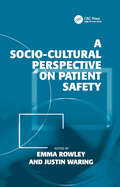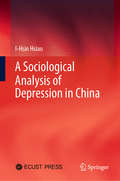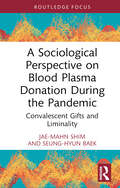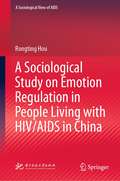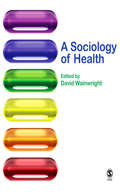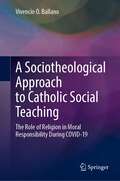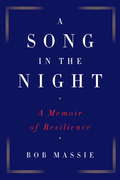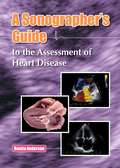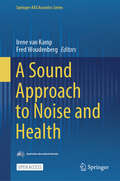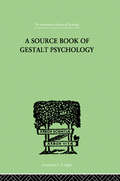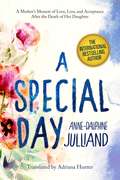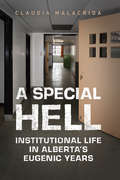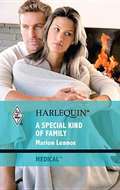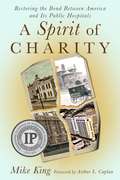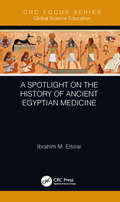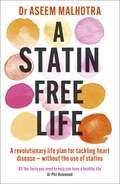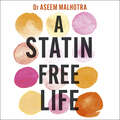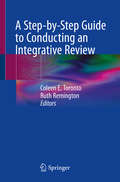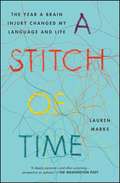- Table View
- List View
A Socio-cultural Perspective on Patient Safety
by Justin WaringThis edited volume of original chapters brings together researchers from around the world who are exploring the facets of health care organization and delivery that are sometimes marginal to mainstream patient safety theories and methodologies but offer important insights into the socio-cultural and organizational context of patient safety. By examining these critical insights or perspectives and drawing upon theories and methodologies often neglected by mainstream safety researchers, this collection shows we can learn more about not only the barriers and drivers to implementing patient safety programmes, but also about the more fundamental issues that shape notions of safety, alternate strategies for enhancing safety, and the wider implications of the safety agenda on the future of health care delivery. In so doing, A Socio-cultural Perspective on Patient Safety challenges the taken-for-granted assumptions around fundamental philosophical and political issues upon which mainstream orthodoxy relies. The book draws upon a range of theoretical and empirical approaches from across the social sciences to investigate and question the patient safety movement. Each chapter takes as its focus and question a particular aspect of the patient safety reforms, from its policy context and theoretical foundations to its practical application and manifestation in clinical practice, whilst also considering the wider implications for the organization and delivery of health care services. Accordingly, the chapters each draw upon a distinct theoretical or methodological approach to critically explore specific dimensions of the patient safety agenda. Taken as a whole, the collection advances a strong, coherent argument that is much needed to counter some of the uncritical assumptions that need to be described and analyzed if patient safety is indeed to be achieved.
A Sociological Analysis of Depression in China
by I-Hsin HsiaoThis book explores the relationship between macro-social structure, social construction and micro-healthcare behaviors. It constructs a two-layered and two-faceted sociological analytical framework to analyze the causes of depression in China and account for the comparatively low rate of depression in the country, and provides a sociological interpretation of depression in China from a global perspective that has rarely been adopted in previous sociological studies in China. Presenting first-hand data and case studies, it describes and analyzes patients’ subjective experience and actions as well as physicians’ viewpoints. It also includes interviews with 34 patients, 4 family members, 3 psychological consultants and 5 psychiatrists.Offering an integrated interpretation of depression in China from the perspectives of sociology, medical science and psychology, this book is intended primarily, but not exclusively, for the growing body of researchers and students who are looking for ways of analyzing depression, especially in China. It is also a valuable resource for practitioners working in the field.
A Sociological Approach to Health Determinants
by Toni SchofieldA Sociological Approach to Health Determinants investigates how 'the social' works in determining health and health inequity. Taking a global perspective, the book shines a light on how experiences of health, illness and health care are shaped by a variety of complex social dynamics. Informed primarily by sociology, the book engages with the WHO's social determinants of health approach and draws on contributions from history, political economy and policy analysis to examine issues such as class, gender, ethnicity and indigeneity, and the impact they have on health. <P> A Sociological Approach to Health Determinants is a comprehensive resource that provides a new perspective on the influence of social structures on health, and how our understanding of the social can ensure improved health outcomes for people all over the globe.
A Sociological Perspective on Blood Plasma Donation During the Pandemic: Convalescent Gifts and Liminality (Routledge Advances in Sociology)
by Jae-Mahn Shim Seung-Hyun BaekShim and Baek examine the evolving existential meanings of gift-making by interviewing donors of convalescent blood plasma during the Covid-19 pandemic.The book reveals what plasma donation means for their efforts to reassemble their lives from being liminal moments to livable experiences, through interviews with convalescent donors in South Korea. It shows it is the very multiplex meanings of plasma donations that enabled people to effectively maneuver through the challenging liminality in life during COVID-19, by expanding the existing literature of gifts and donation that highlights the rich, complex meanings of the body parts donated. It presents a vivid dialogue between liminality and gift-making from varied narratives.A vital read for scholars, students of sociology, anthropology, and public health and those interested in how subjects reconstitute their agency amid uncertainty inside and outside the pandemic, so that we appreciate the voices of donors and learn from the lived experiences of those in this book.
A Sociological Study on Emotion Regulation in People Living with HIV/AIDS in China (A\sociological View Of Aids Ser.)
by Rongting HouThis book explores the experiences and emotional expression of 30 people Living with HIV/AIDS (PLWHA) using qualitative research methods such as “illness narratives,” and analyzes the dilemmas of “sicknesses of the society” including “Acquired Needs Deficiency” Syndrome, “Acquired Expectation Insufficiency” Syndrome, and “Acquired Punishment” Syndrome at the micro, meso and macro levels, so as to investigate higher-intensity negative emotions.In turn, the book draws on the perspectives of conflict and game, structure and function, and system and interaction, in order to propose a dynamic mechanism of emotion and expression, and argues that these negative emotions can be transformed, strengthened and presented through defense mechanisms such as suppression and attribution, which will influence social institutions at the micro, meso and macro levels and even possibly bring about positive changes in the social structure.
A Sociology of Health
by Dr David Wainwright`A Sociology of Health charts a way forward for a medical sociology that can make a positive contribution to medical practice and health policy' - Dr Michael Fitzpatrick, East London GP and author of The Tyranny of Health `This is a very lively book that will stimulate good debate amongst students undertaking sociology of health courses in higher education' - Mathew Jones, Senior Lecturer in Health and Social Policy, University of the West of England A Sociology of Health offers an authoritative and up-to-date introduction to the key issues, perspectives and debates within the field of medical sociology. The book will aid readers' understanding of how sociological approaches are crucial to understanding the impact that health and illness have on the behaviour, attitudes, beliefs, and practices, of an increasingly health-aware population. The book is topical and unique in its approach, combining commentary and analysis of classic debates in medical sociology with contemporary issues in health care policy and practice. The content is wide-ranging, including chapters on: health scares, therapy culture, new dimensions of international health, changes in health care organisation and the feminization of health. Features such as case studies, questions for debate, and further reading sections are used throughout to promote critical reflection and further debate. A Sociology of Health offers readers a fresh approach to the subject, and will be essential reading for all undergraduate students on medical sociology and sociology of health and illness courses, as well as postgraduate students in related health and social care disciplines. David Wainwright is a Senior Lecturer in the School for Health, University of Bath.
A Sociotheological Approach to Catholic Social Teaching: The Role of Religion in Moral Responsibility During COVID-19
by Vivencio O. BallanoThis book introduces Catholic social teaching (CST) and its teaching on the common good to the reader and applies them in the realm of public health to critically analyze the major global issues of COVID-19 that undermine public interest. It uses the sociotheological approach that combines the moral principles of CST and the holistic analysis of modern sociology and also utilizes the secondary literature as the main source of textual data. Specifically, it investigates the corporate moral irresponsibility and some unethical business practices of Big Pharma in the sale and distribution of its anti-COVID vaccines and medicines, the injustice in the inequitable global vaccine distribution, the weakening of the United States Congress’s legislative regulation against the pharmaceutical industry’s overpricing and profiteering, the inadequacy of the World Health Organization’s (WHO) law enforcement system against corruption, and the lack of social monitoring in the current public health surveillance system to safeguard the public good from corporate fraud and white-collar crime. This book highlights the contribution of sociology in providing the empirical foundation of CST’s moral analysis and in crafting appropriate Catholic social action during the pandemic. It is hoped that through this book, secular scholars, social scientists, religious leaders, moral theologians, religious educators, and Catholic lay leaders would be more appreciative of the sociotheological approach to understanding religion and COVID-19. “This book brings into dialogue two bodies of literature: documents of Catholic social teaching, and modern sociology and its core thinkers and texts...The author does especially well to describe how taking ‘the sociotheological turn’...will benefit the credibility and dissemination of Catholic social thought.”- Rev. Fr. Thomas Massaro, S.J., Professor of Moral Theology, Jesuit School of Theology, Santa Clara University, Berkeley, California.
A Son for John
by Gill SandersonIt is a shock for John Cord, newly appointed Specialist Registrar in Obstetrics and Gynaecology, when he finds that the ward sister he must work closely with is his ex-girlfriend Eleanor. Refusing John's offer of marriage, Eleanor ran away to New Zealand six years previously when she found she was carrying his child, determined to be independent. She only asked that he never tried to get in touch. John finds an unexpected joy at his newly discovered son, but will Eleanor take the risk of restarting what didn't work out before?
A Son for John: A Heartfelt Medical Romance (Medical Romances #4)
by Gill SandersonAnother captivating medical romance by best-selling author Gill Sanderson! Perfect for fans of Mia Faye, Laura Scott, Helen Scott Taylor, Grey's Anatomy and ER.Readers ADORE Gill's gripping medical romances!'Fabulous book & author....' 5* reader review'I heartily recommend this book for you to read as soon as possible... Really remarkable writer!' 5* reader review'It was a good read I enjoyed it from beginning to end would recommend it' 5* reader reviewIs this a risk worth taking?John Cord, newly appointed Specialist Registrar in Obstetrics and Gynaecology, receives a shock when he finds that the ward sister he must work closely with is his ex-girlfriend Eleanor. Refusing John's offer of marriage, Eleanor ran away to New Zealand six years previously when she discovered she was carrying his child, determined to be independent.The only thing she'd asked is that he never tried to get in touch. John finds an unexpected joy at his newly discovered son, but will Eleanor take the risk of restarting what didn't work out before?Don't miss Gill Sanderson's enthralling medical romances, including the A Lakeland Practice and the Good, Bad and Ugly series.
A Song in the Night
by Bob MassieIn this inspiring memoir of faith and perseverance, Bob Massie recounts how a childhood illness laid the foundation for a life filled with compassion and activism.Bob Massie was born with classical hemophilia, a painful disorder that caused repeated bleeding in his joints and slowly robbed him of the ability to walk. Though bound to leg braces and wheelchairs as a child, his curiosity and enthusiasm pulled him relentlessly outward toward knowledge and people. Gradually he fought back and eventually succeeded not only in walking again but in traveling widely through a life of passion and commitment. He graduated in history from Princeton, where he organized the opening up of the university's exclusive club system, and later was ordained as an Episcopal minister. After several years teaching children and working with the homeless in New York City, he moved to the challenging halls of Harvard Business School, where he earned a doctorate while tending to a devoted but struggling congregation in the working-class city of Somerville, Massachusetts.Though the medical dangers increased--he had acquired the HIV and hepatitis through transfusions for hemophilia--he continued to press for justice. He wrote a prizewinning book on South African apartheid, led one of America's most innovative environmental groups, ran for lieutenant governor in Massachusetts, and created the world's leading standard for corporate sustainability. Then, in 2002, the same year Massie was named one of the 100 most influential people in the field of finance by CFO magazine, he received more devastating health news. The hepatitis was causing his liver to fail, and Massie was brought close to death in 2009.After surviving these remarkable challenges, Bob Massie is now ready to share his story. Though his journey has not been easy, he writes about it with tremendous grace and candor. In an era rife with disillusionment, A Song in the Night will inspire everyone who reads it."A good friend and a visionary leader, Bob Massie has combined foresight, passion, and skill to create lasting change in the US and around the world. In A Song in the Night, Bob shares deeply personal stories that help describe how he overcame great challenges to forge such strong commitments for his work and family. Bob has lived an incredible life, and we are so fortunate that he has shared it with us in this wonderful new book." --Al Gore"I admire and deeply respect Bob Massie's courage, his compassion, and his eloquence. He is a good man. His life's work has focused on social justice, public service, and faith, and I know he will continue to work tirelessly to make this a more just world." --Elizabeth WarrenFrom the Hardcover edition.
A Sonographer's Guide to the Assessment of Heart Disease
by Bonita AndersonWritten by a sonographer for sonographers, this text primarily discusses the role of echocardiography in the assessment of heart diseases. The book is mostly designed for students of echocardiography, teachers of echocardiography and cardiac sonographers working in routine clinical practice, but will also be very useful to echocardiologists and cardiac registrars. The goal of the text is to provide a comprehensive review of transthoracic echocardiography in the assessment of various cardiac pathologies. Refresher notes on cardiac anatomy and the relevant cardiac physiology and pathophysiology are included to expand the cardiac sonographer's knowledge in this area and further their understanding of various diseases, disease processes and associated findings. This comprehensive text is supported by over 720 figures including over 1,200 echo images, over 130 pathological photos and many illustrations. It also includes several appendices, numerous tables and technical tips which highlight key concepts. Hard-cover bound with 507 printed pages, this text is ready to be adopted as any sonographer's constant companion while dealing with the many challenges that arise in performing an echocardiographic examination.
A Sound Approach to Noise and Health (Springer-AAS Acoustics Series)
by Irene Van Kamp Fred WoudenbergThis open access book highlights the negative and positive health effects of chronic exposure to environmental sound. It describes the state of the art in the field from a public health point of view and puts it in a broad societal perspective looking at sound from physical, social, psychological, economic and governance angles. Rather than a mere collection of papers around the theme as usually provided in special issues, this book offers a comprehensive look at the meaning of sound in society and its impacts and provides directions to further advance the field.
A Sound of Freedom: One man's war against the KGB
by Walter GrantTroubled by a large number of KGB agents operating freely in the US, the lackadaisical attitude of the general population, and the media's irresponsible depiction of communism, an ex-double agent sets out to use all he has learned in his position as a captain in the KGB's western intelligence section. He was all that stood between the soviets and their plan to take control of the first test launch of the Peacekeeper--America's newest ICBM. The soviets aimed to destroy several cities along the southern California coast--an apparent accident. This, they surmised, would show America too incompetent and irresponsible to be allowed to develop high-tech weapons. The Soviet Union would become the world's only super power. The marine has his own demons to fight, both past and present. Complicating his life and his one man war against the KGB is the woman he met and fell in love with--she is a mystery.
A Source Book Of Gestalt Psychology (International Library Of Psychology Ser.)
by Ellis, Willis DThis is Volume II of twenty-one in a series of Cognitive Psychology. Originally published in 1938. The war, differences of tongue, sentiment, and background all contributed towards making it difficult for English-speaking readers to welcome what they were the experimental methods and results of certain German psychologists. The gap thus created was not bridged until very recent times: notably by the publication in 1935 of Professor K. Koffka’s Principles of Gestalt Psychology. Even this important work, however, does not wholly effect the necessary transition from the German psychology of 1912 to the present day, and Professor Koffka himself mentions this in a Preface footnote of his book. The present volume is offered in the hope that it may play a part in completing the structure.
A Special Day
by Adriana Hunter Anne-Dauphine JulliandFebruary 29th is a date that comes into existence just once every four years. It is also the birthday of Thaïs-author Anne-Dauphine Julliand's darling daughter-who died of a genetic disease. Thaïs lived just shy of her fourth birthday. She had a short life but good one.As this special day is about to reappear on her calendar for the first time since her daughter passed away, Anne-Dauphine struggles with how to mark this momentous occasion. She wants to live fully on this special day: Thais would have been eight years old. Vivid memories of life with her daughter begin to blend with the present-every gesture, every word evokes a buried memory, arouses laughter or tears. Yet as the date of her daughter's birthday approaches, she knows she must not lose sight of the family who needs her now: her sons Gaspard and Arthur, and Azylis, her other daughter who is also sick.Anne-Dauphine's message remains simple, true, and strong: we all need to be loved and we all need to be happy despite our ordeals. This is both lesson in happiness and a wonderful love story-A Special Day is an honest, inspirational tale that has touched the hundreds of thousands of lives. It will leave the reader breathless with its beauty.
A Special Hell: Institutional Life in Alberta's Eugenic Years
by Claudia MalacridaUsing rare interviews with former inmates and workers, institutional documentation, and governmental archives, Claudia Malacrida illuminates the dark history of the treatment of "mentally defective" children and adults in twentieth-century Alberta. Focusing on the Michener Centre in Red Deer, one of the last such facilities operating in Canada, A Special Hell is a sobering account of the connection between institutionalization and eugenics. Malacrida explains how isolating the Michener Centre's residents from their communities served as a form of passive eugenics that complemented the active eugenics program of the Alberta Eugenics Board. Instead of receiving an education, inmates worked for little or no pay - sometimes in homes and businesses in Red Deer - under the guise of vocational rehabilitation. The success of this model resulted in huge institutional growth, chronic crowding, and terrible living conditions that included both routine and extraordinary abuse. Combining the powerful testimony of survivors with a detailed analysis of the institutional impulses at work at the Michener Centre, A Special Hell is essential reading for those interested in the disturbing past and troubling future of the institutional treatment of people with disabilities.
A Special Kind of Family
by Marion LennoxHaving recently accepted a new job and rejected a marriage proposal, Dr. Erin Carmody was already reeling. So, after crashing her car and staggering to the door of Dr. Dom Spencer, she barely knew which way was up. At least that was how she rationalized the crazy, wonderful attraction she felt for this man she'd only just met. But as Erin healed, she began to believe in the unbelievable. Perhaps she was meant to be here--helping Dom care for the people of Bombadeen, being a mother to his foster sons. Dom had shown her what true love was--if only he'd let her prove to him that what they had was real....
A Spirit of Charity: Restoring the Bond Between America and Its Public Hospitals
by Arthur L. Caplan Mike KingMost Americans view the nation's great public hospitals as refuges of last resort for poor and uninsured people. But these iconic institutions -- some recently closed, some renamed, others rebuilt -- have also served as a safety valve for the nation's highly profitable medical industrial complex. They are a key to understanding the evolution of America's $3 trillion health care system, not just for the poor, but the affluent as well, argues veteran journalist Mike King. Through an examination of their unique history and an incisive analysis of policy successes and failures, A Spirit of Charity reveals the remarkable story of why public hospitals matter and why they should play a more prominent role in our public policy discussions.
A Spiritual Journey Through Breast Cancer
by Judy AstiTraces the author's journey--physically, psychologically, and spiritually--through her bout with breast cancer
A Spotlight on the History of Ancient Egyptian Medicine (Global Science Education)
by Ibrahim EltoraiThis unique volume provides the reader with an outline of ancient Egyptian civilization, history and culture. It reviews the ancient Egyptian understanding of human health and disease, medical and herbal treatments for various conditions based on primary sources found in ancient papyri. The reader will also gain an insight into the influence of ancient Egyptian medical knowledge on later civilizations including ancient Greek and Islamic scholars in the middle ages. There are two chapters that focus on the ancient Egyptian understanding and treatments of cardiovascular disease as well as a description of herbal medicines used by medical practitioners and pharmacologists. Key Features: Describes influence of ancient Egyptian medical and pharmaceutical knowledge of subsequent civilizations Explores ancient Egyptian pharmacology and herbal medicine Review of the most significant ancient Egyptian papyri documenting medical knowledge and practice Concise overview of ancient Egyptian history, culture, medical knowledge Summary of ancient Egyptian understanding of cardiovascular diseases and treatments
A Statin-Free Life: A revolutionary life plan for tackling heart disease – without the use of statins
by Aseem Malhotra'Giving you all the facts to help you decide how best to have a healthy life. - Dr Phil HammondStatins are among the most widely prescribed drugs in the world. Yet many report unacceptable side effects and a US survey revealed that 75 per cent of respondents stopped taking them within a year. So what is the evidence for their benefits? Dr Aseem Malhotra, author of the bestselling The 21-Day Immunity Plan and co-author of the bestselling The Pioppi Diet, examines the claims for statins and their role in lowering cholesterol and preventing heart disease. He introduces us to his targeted heart-health plan, which, with a diet plan, recipes and advice on reducing stress and increasing movement, can help us to live statin-free and take control of our own health.'Backed by science, this is a riveting read for anyone with a heart.' - Liz Earle'Aseem's programme gives you the best opportunity for a v long and healthy life.' - Ross Walker'Get this book to figure out if a statin-free life is right for you.' - Dr Robert Lustig
A Statin-Free Life: A revolutionary life plan for tackling heart disease – without the use of statins
by Dr Aseem Malhotra'Giving you all the facts to help you decide how best to have a healthy life. - Dr Phil HammondStatins are among the most widely prescribed drugs in the world. Yet many report unacceptable side effects and a US survey revealed that 75 per cent of respondents stopped taking them within a year. So what is the evidence for their benefits? Dr Aseem Malhotra, author of the bestselling The 21-Day Immunity Plan and co-author of the bestselling The Pioppi Diet, examines the claims for statins and their role in lowering cholesterol and preventing heart disease. He introduces us to his targeted heart-health plan, which, with a diet plan, recipes and advice on reducing stress and increasing movement, can help us to live statin-free and take control of our own health.'Backed by science, this is a riveting read for anyone with a heart.' - Liz Earle'Aseem's programme gives you the best opportunity for a v long and healthy life.' - Ross Walker'Get this book to figure out if a statin-free life is right for you.' - Dr Robert Lustig
A Statin-Free Life: A revolutionary life plan for tackling heart disease – without the use of statins
by Dr Aseem Malhotra'Giving you all the facts to help you decide how best to have a healthy life. - Dr Phil HammondStatins are among the most widely prescribed drugs in the world. Yet many report unacceptable side effects and a US survey revealed that 75 per cent of respondents stopped taking them within a year. So what is the evidence for their benefits? Dr Aseem Malhotra, author of the bestselling The 21-Day Immunity Plan and co-author of the bestselling The Pioppi Diet, examines the claims for statins and their role in lowering cholesterol and preventing heart disease. He introduces us to his targeted heart-health plan, which, with a diet plan, recipes and advice on reducing stress and increasing movement, can help us to live statin-free and take control of our own health.'Backed by science, this is a riveting read for anyone with a heart.' - Liz Earle'Aseem's programme gives you the best opportunity for a v long and healthy life.' - Ross Walker'Get this book to figure out if a statin-free life is right for you.' - Dr Robert Lustig(P) 2021 Hodder & Stoughton Limited
A Step-by-Step Guide to Conducting an Integrative Review
by Coleen E. Toronto Ruth RemingtonThis book provides guidance to readers for how to conduct an integrative review. Over the decades, with the expansion of evidence-based practice (EBP), the evolution of methods used in reviews has resulted in a wide spectrum of review types. Due to the overlapping characteristics of the various review methods, confusion exists related to terminology, descriptions and methods of each type. To fill this gap, this book examines components necessary to conduct a rigorous integrative review from formulating questions through dissemination of the results of the review. Each chapter focuses on one component or step in this process and is written in a straightforward and readable manner. An integrative review is considered by many as an actual research study, hence it should be approached following established research methods involving well‐defined steps. The integrative review is often compared with the systematic review. Both are used in healthcare research and follow a systematic process in reviewing literature and developing recommendations, but there are important differences that are addressed in the book. Evidence-based practice (EBP) demands high quality, rigorous evidence for nurse clinicians to make informed decisions with and for their patients. In nursing education, the integrative review is a frequent capstone project for graduate students and forms the basis for many doctoral projects. The Integrative review process should be valid, reliable and transparent and this book provides clear guidelines for writing an integrative review for students, educators, clinicians, and researchers. This book is a useful addition to courses for both undergraduate and graduate level writers of integrative reviews. In academia, a likely adoption would be in graduate research and research methods courses, and baccalaureate honor courses.
A Stitch of Time: The Year a Brain Injury Changed My Language and Life
by Lauren MarksFor fans of Brain on Fire and My Stroke of Insight, an incredible first-person account of one woman’s journey to regaining her language and identity after a brain aneurysm affects her ability to communicate.Lauren Marks was twenty-seven, touring a show in Scotland with her friends, when an aneurysm ruptured in her brain and left her fighting for her life. She woke up in a hospital soon after with serious deficiencies to her reading, speaking, and writing abilities, and an unfamiliar diagnosis: aphasia. This would be shocking news for anyone, but Lauren was a voracious reader, an actress, director, and dramaturg, and at the time of the event, pursuing her PhD. At any other period of her life, this diagnosis would have been a devastating blow. But she woke up...different. The way she perceived her environment and herself had profoundly changed, her entire identity seemed crafted around a language she could no longer access. She returned to her childhood home to recover, grappling with a muted inner monologue and fractured sense of self. Soon after, Lauren began a journal, to chronicle her year following the rupture. A Stitch of Time is the remarkable result, an Oliver Sacks–like case study of a brain slowly piecing itself back together, featuring clinical research about aphasia and linguistics, interwoven with Lauren’s personal narrative and actual journal entries that marked her progress. Alternating between fascination and frustration, she relearns and re-experiences many of the things we take for granted—reading a book, understanding idioms, even sharing a “first kiss”—and begins to reconcile “The Girl I Used to Be” with “The Girl I Am Now.” Deeply personal and powerful, A Stitch of Time is an unforgettable journey of self-discovery, resilience, and hope.
